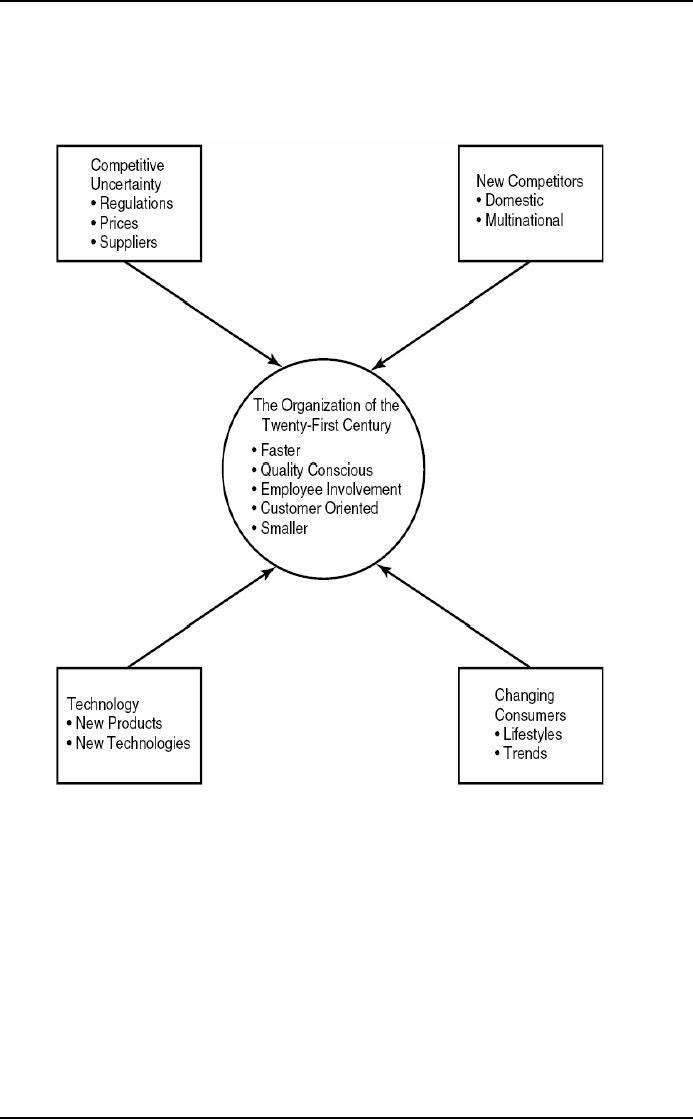 |

Organization
Development MGMT
628
VU
Lesson
03
What
an "ideal" effective, healthy organization
would look like?
Numbers of
writers and practitioners in the field
have proposed definitions which,
although they differ in
detail,
indicate a strong consensus of what a healthy
operating organization is.
An
effective organization is one in which:
1.
The total organization, the significant
subparts, and individuals,
manage their work against
goals
and
plans for achievement of
these goals.
2.
Form follows function (the
problems, or task, or project, determines
how the human resources
are
organized).
3.
Decisions are made by and
near the sources of information
regardless of where these
sources are
located
on the organization chart.
4.
The reward system is such
that managers and
supervisors are rewarded
(and punished)
comparably
for:
Sort-term
profit or production performance,
Growth and development of their
subordinates, and
creating
a viable working group.
5.
Communication laterally and vertically is relatively undistorted.
People are generally open
and
confronting.
They share all the relevant facts
including feelings.
6.
There is a minimum amount of inappropriate
win/lose activities between individuals
and groups.
Constant
effort exists at all levels
to treat conflict, and conflict
situations, as problems subject
to
problem-solving
methods.
7.
There is high "conflict" (clash of
ideas) about tasks and
projects, and relatively little
energy spent in
clashing
over interpersonal difficulties because
they have been generally
worked through.
8.
The organization and its
parts see themselves as interacting with
each other and with a
larger
environment.
The organization is an "open
system."
9.
There is a shared value, and
management strategy to support it, of
trying to help each person
(or
unit)
in the organization maintains his (or
its) integrity and
uniqueness in an interdependent
environment.
10.
The organization and its
members operate in an "action-research"
way. General practice is to
build
in
feedback mechanisms so that
individuals and groups can
learn from their own
experience.
The
only constant is
Change:
Although
many organizations have been
able to keep pace with the
changes in information technology,
few
firms
have been able to adapt to
changing social and cultural conditions.
In a dynamic environment,
change
is
unavoidable. The pace of change
has become so rapid that it
is difficult to adjust to or compensate
for
one
change before another is necessary.
Change is, in essence, a
moving target. The technological,
social,
and
economic environment is rapidly
changing, and an organization will be
able to survive only if it
can
effectively
respond to these changing
demands. As we move into the twenty
first century, increases in
productivity
of 100 percent, not 10
percent, will be required for
corporations to compete
effectively.
Given
this increasingly complex environment, it
becomes even more critical
for management to
identify
and
respond to forces of social
and technical change. In attempting to
manage today's organizations,
many
executives
find that their past
failures to give enough attention to the
changing environment are
how
creating
problems for them. In
contrast 3M Corporation has developed an
outstanding reputation for
innovation.
3M is big but acts small.
3M's 15 percent rule allows
its people to spend up to 15 percent of
the
work
week on anything as long as it is
product related. The most
famous example to come out
of this is
Post-it
note.
The
Organization of the Future:
The
fundamental nature of managerial success
is changing. The pace of this
change is relentless,
and
increasing
past sources of competitive
advantage, such as economies of
scale and huge advertising
budgets,
is
no longer as effective in the new competitive
landscape. Moreover, the traditional
managerial approach
can
no longer lead a firm to economic
leadership. (See the OD in Practice what
Trilogy Software is
doing
to
become a successful company of the
future.)
Today's
managers need a new mind
set one that values
flexibility, speed, innovation,
and the challenge
that
evolves from constantly
changing conditions. Virtual
organizations can spring up
overnight as
networks
of free agents combine
expertise for a new project
or produce. Nothing could be more
flexible,
ready
to turn on a dime and grab
any new opportunity.
Management theorists believe
that to be successful
in
the next century, organizations will
require changes of the kind in the figure
2 They suggest that
predictability
is a thing of the past, and
that the winning organization of today
and tomorrow, it is
becoming
increasingly clear, will be
based upon quality,
innovation, and
flexibility.
These
successful firms will share
certain common traits including

Organization
Development MGMT
628
VU
Faster
more
responsive to innovation and
change
Quality
conscious totally
committed to quality
Employee
involvement adding
value through human
resources
Customer
oriented creating
niche markets
Smaller
made
up of more autonomous units
Figure:
02
Fig.
1.2. The Changing Organization of
the

Organization
Development MGMT
628
VU
OD
in Practice: Trilogy Software A
New Kind of
Company:
A
dropout of Stanford, Joe Liemandt, formed
a small software company,
Trilogy Software Inc., in
Austin,
Texas,
in 1989. Starting with a
small investment, the company grew
from 400 to 1000 employees
within a
short
span of four years. Today,
Trilogy is among the world's largest
privately held software companies
and
is
a leading provider of industry-specific
software.
To
call all those who
work for Trilogy as
"workers" would be wrong. They are
all shareholders. They are
all
managers.
They are all
partners.
The
founder, since its start,
knows one thing that is
Trilogy depends on talented people. He
also knows
that
people can go anywhere, join
any of the competitive companies,
which means that his
biggest
competitive
headache isn't companies.
His biggest worry is holding
onto people. "There is
nothing more
important
than recruiting and
developing people," he says.
"That's my number-one job. Trilogy is
going
head-to-head
with Microsoft and other
biggies in the talent war.
They
have a very clear teachable
point of view of what Trilogy is
and what they practice. They know
how
to
energize people, how to make
courageous decisions. The
CEO personally teaches a
large portion of the
classes
held for Trilogy's employee recruitment
and development program the glue
that binds.
Trilogy
has some unusual practices,
including perks like
speedboat for water skiing
available to all
employees,
fully stocked kitchens on
every floor, and parties
every Friday. And there
are spontaneous
awards,
such as a sports car for
good work and trip to a
Las Vegas. The CEO
once took the entire
company
on a week-long, all-expense-paid trip to
Hawaii. Bonuses are given to
top performers that
are
equal
to 50 or 100 percent of their
regular salaries.
The
economy is fostering new kinds of
organizations with new kinds of
practices and operating rules
for
pulling
people together. These companies offer
many of the advantages of free
agency; flexibility in
how,
when,
and where you work;
compensation linked to what you
contribute; freedom to move from project
to
project.
However, they also offer the
advantages of belonging to an organization in
which mutual
commitment
builds continuity.
Table of Contents:
- The Challenge for Organizations:The Growth and Relevance of OD
- OD: A Unique Change Strategy:OD consultants utilize a behavioral science base
- What an “ideal” effective, healthy organization would look like?:
- The Evolution of OD:Laboratory Training, Likert Scale, Scoring and analysis,
- The Evolution of OD:Participative Management, Quality of Work Life, Strategic Change
- The Organization Culture:Adjustment to Cultural Norms, Psychological Contracts
- The Nature of Planned Change:Lewin’s Change Model, Case Example: British Airways
- Action Research Model:Termination of the OD Effort, Phases not Steps
- General Model of Planned Change:Entering and Contracting, Magnitude of Change
- The Organization Development Practitioner:External and Internal Practitioners
- Creating a Climate for Change:The Stabilizer Style, The Analyzer Style
- OD Practitioner Skills and Activities:Consultant’s Abilities, Marginality
- Professional Values:Professional Ethics, Ethical Dilemmas, Technical Ineptness
- Entering and Contracting:Clarifying the Organizational Issue, Selecting an OD Practitioner
- Diagnosing Organizations:The Process, The Performance Gap, The Interview Data
- Organization as Open Systems:Equifinality, Diagnosing Organizational Systems
- Diagnosing Organizations:Outputs, Alignment, Analysis
- Diagnosing Groups and Jobs:Design Components, Outputs
- Diagnosing Groups and Jobs:Design Components, Fits
- Collecting and Analyzing Diagnostic information:Methods for Collecting Data, Observations
- Collecting and Analyzing Diagnostic information:Sampling, The Analysis of Data
- Designing Interventions:Readiness for Change, Techno-structural Interventions
- Leading and Managing Change:Motivating Change, The Life Cycle of Resistance to Change
- Leading and managing change:Describing the Core Ideology, Commitment Planning
- Evaluating and Institutionalizing Organization Development Interventions:Measurement
- Evaluating and Institutionalizing Organization Development Interventions:Research Design
- Evaluating and Institutionalizing Organization Development Interventions
- Interpersonal and Group Process Approaches:Group Process
- Interpersonal and Group Process Approaches:Leadership and Authority, Group Interventions
- Interpersonal and Group Process Approaches:Third-Party Interventions
- Interpersonal and Group Process Approaches:Team Building, Team Building Process
- Interpersonal and Group Process Approaches:Team Management Styles
- Organization Process Approaches:Application Stages, Microcosm Groups
- Restructuring Organizations:Structural Design, Process-Based Structures
- Restructuring Organizations:Downsizing, Application Stages, Reengineering
- Employee Involvement:Parallel Structures, Multiple-level committees
- Employee Involvement:Quality Circles, Total Quality Management
- Work Design:The Engineering Approach, Individual Differences, Vertical Loading
- Performance Management:Goal Setting, Management by Objectives, Criticism of MBO
- Developing and Assisting Members:Career Stages, Career Planning, Job Pathing
- Developing and Assisting Members:Culture and Values, Employee Assistance Programs
- Organization and Environment Relationships:Environmental Dimensions, Administrative Responses
- Organization Transformation:Sharing the Vision, Three kinds of Interventions
- The Behavioral Approach:The Deep Assumptions Approach
- Seven Practices of Successful Organizations:Training, Sharing Information